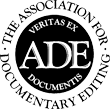Reviews
The Papers of Eliza Lucas Pinckney and Harriott Pinckney Horry: Digital Edition. Edited by Constance Schulz, Robin Copp, Mary Sherrer, Nicollette Calhoun, Peggy Clark, Taylor Kirton, Rachel Love, Justin McIntyre, Neal Millikan, and Benjamin Sheinkin. Charlottesville, VA: Rotunda, 2012. $60 (individuals). $115–$595 (institutional).
For historians of early America, Eliza Lucas Pinckney is the southern Abigail Adams: an erudite and well-connected female whose unusually rich surviving archive makes her the other go-to exemplar of white womanhood in colonial and revolutionary America. Known chiefly through her published letterbook as a pioneer of indigo cultivation in colonial South Carolina, and also as the mother of patriots—her two sons were prominent revolutionaries and later Federalists—Pinckney is a well-known and worthy subject.
Her equally worthy daughter, Harriott Pinckney Horry, is less widely known today, though she left three fascinating travel journals and a recipe book, besides her significant correspondence. Like her mother, Horry was an active and knowledgeable plantation mistress, in part because she (also like her mother) was widowed at a relatively early age. As Constance Schulz observes in her introduction to this excellent collection, Horry's "life paralleled that of her mother in many ways, but also illustrates some of the profound changes which women of the South experienced after American independence."
This born-digital edition includes every document written by or to Pinckney and Horry, along with some others (mostly family correspondence) that shed further light on their lives. Schulz divides the documents into three sections—correspondence, legal, and financial papers; Horry's travel journals; and recipe books from both women—though readers can search all these collections simultaneously. Pinckney-Horry family letters constitute the bulk of the documents, most of which are published here for the first time. A 1972 print edition of Eliza Lucas Pinckney's letterbook stopped in 1762, though Pinckney lived until 1793. A print edition of Harriott Pinckney Horry's cookbook—included here in a downloadable digital format—was published in 1984, but Horry's letters and travel journals have not previously been published.
In form and spirit, this project builds on Holly Shulman's Dolley Madison Digital Edition, also published by Rotunda, the digital imprint of the University of Virginia Press. As Schultz explains, she shares Shulman's belief that female members of the founding generation of the American republic had compelling stories, many of which can be told through their papers. Shulman's digital edition of Dolley Madison's papers, which meets current scholarly standards for documentary editing, is the prototype for Schulz's project. In an ideal world, other digitized collections of women's papers will follow, published on the same platform to create "the possibility that scholars using such editions could search digitally across the writings of many women for their common experiences and concerns."
The documents here are fully searchable by keyword, author, recipient, document type, date, place, and topic. The topics preloaded in the search box suggest the gendered nature of the documents. While the topic "health/illness" (ranked first with 333 hits) reflects the universality of such concerns in a comparatively perilous era, the preponderance of documents pertaining to "family" (second with 270 hits) and "children" (third with 261) shows the dominant preoccupations of even these most cosmopolitan southern women. That said, Pinckney and Horry were also knowledgeable about agriculture (188 hits) and politics (46 hits), and their papers include letters exchanged with family members about military engagements during the Revolution, and also two that Horry sent to General Nathaniel Greene to request permission (apparently unsuccessfully) to export rice to London "for the maintenance and Education" of her son who attended school there during the war.
Both Pinckney and Horry were accomplished plantation mistresses, and their recipe books offer a window onto women's work and domestic life. Perhaps not surprisingly, certain recipes appear in both Pinckney's and Horry's collections. Pinckney's book has more nonfood entries, ranging from the medicinal (including a beeswax "salve for corns") to the fanciful ("how to grow hair"), though Horry's book also includes some home remedies and instructions for household hints, such as how to use rice flour to make "cheap paint."
Notwithstanding their domestic duties and occupations, mother and daughter were well traveled for women of their era. Pinckney's early letters chronicle her years in London as a young wife and mother. Truly a denizen of the British Atlantic world, she was born in Antigua, lived later in South Carolina and in London, and maintained transatlantic friendships for much of her life. Horry's journals record her tour of the northern states in 1793 (which began with a sojourn in Philadelphia, where her mother died of breast cancer), travels in South Carolina in 1795, and another trip northward in 1815. An enthusiastic and well-informed tourist, Horry readily absorbed (and reported) information about battlefields, religious sects, agricultural methods, social life, technological advances, and other subjects. Unfortunately, her journal is difficult to read in its original state—in other words, as one continuous book—because each entry is treated here as a separate document, which requires the reader to return to the list of contents to advance to each subsequent entry. Adding buttons to click for the "next" and "previous" entries would be a huge improvement.
Overall, however, this collection is remarkably well orchestrated. Documents have been expertly transcribed and thoroughly annotated. Each has an accompanying sidebar that includes links to an impressive glossary, which identifies people, places, and terms as well as the relevant topics under which the document is cross-listed. Also included in the sidebar is a brief summary of the document. Though few in number, maps and illustrations are useful. The family trees are less so: difficult to read, they nonetheless provide essential information to readers who are patient enough to manipulate them effectively.
Historians of the colonial, revolutionary, and early republican eras will appreciate this excellent collection and share my hope that more such editions of papers of the so-called Founding Mothers will be forthcoming. The Papers of Eliza Lucas Pinckney and Harriott Pinckney Horry is a welcome contribution to the fields of early American, southern, and women's history.
 PDF
PDF
